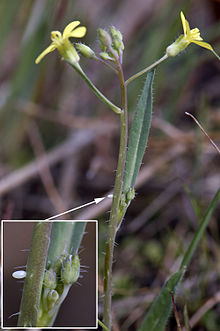Rapeseed white butterfly
| Rapeseed white butterfly | ||||||||||||
|---|---|---|---|---|---|---|---|---|---|---|---|---|

Rapeseed White ( Pieris napi ) |
||||||||||||
| Systematics | ||||||||||||
|
||||||||||||
| Scientific name | ||||||||||||
| Pieris napi | ||||||||||||
| ( Linnaeus , 1758) |
The rapeseed white ( Pieris napi ) is a butterfly ( butterfly ) from the family of white flies (Pieridae). It is also often referred to as the green vein white or the hedge white .
features
The rapeseed white butterfly is a medium-sized butterfly with a wingspan of around 50 millimeters, which is one of the most common butterfly species . The main distinguishing feature are the greenish scaly veins on the yellow underside of the hind wings. The underside of the forewing is white and turns yellowish towards the tip. The top is also white and has light gray-green veins. In the male there is an equally colored spot, in the female there are two. At the wing tips, the forewings here turn dark gray.
The caterpillar resembles that of the small cabbage white butterfly , but has no pronounced yellow back line, but is rather light green with fine yellow lateral points.
Similar species
- Mountain white butterfly ( Pieris bryoniae ) (Pieridae)
- Pieris ergane (Pieridae)
- Krüpers Weißling ( Pieris krueperi ) (Pieridae)
- Small cabbage white butterfly ( Pieris rapae ) (Pieridae)
Subspecies
- Pieris napi adalwinda (Fruhstorfer, 1909) Orsa Finnmark , Sweden
- Pieris napi meridionalis
- Pieris napi segonzaci (le Cerf, 1923) High Atlas
- Pieris napi maura (Verity, 1911) Glacières de Blida , Algeria
- Pieris napi atlantis (Oberthür, 1923) Azrou , Middle Atlas , Morocco
- Pieris napi flavescens (Wagner, 1903) Mödling , Austria
Synonyms
- Pieris adalwinda Fruhstorfer , 1909
- Pieris arctica Verity , 1911
- Pieris canidiaformis Drenowsky , 1910
- Pieris dubiosa Röber , 1907
- Pieris flavescens Wagner , 1903
- Pieris meridionalis Heyne , 1895
Occurrence
The butterfly is widespread in almost all of Europe, from Scandinavia to the Mediterranean . It is absent on the Atlantic Islands, the Shetland Islands and Sardinia .
The habitat of the rapeseed white butterfly includes moist, grassy places with some shade, forest edges, tree hedges, greasy meadows and wooded river valleys. The later generations expand their catchment area in search of alternative forage plants in drier, but flower-rich locations. In the Mediterranean area, bushes near mountain streams or springs or floodplains with watercress ( Nasturtium officinale ) are typical.
Way of life
The forage plants of the caterpillar include foam herb species ( Cardamine ), but also various types of cress such as real watercress ( Nasturtium officinale ), mustard ( Sinapis ) and garlic ( Allium sativum ). It is questionable whether the eponymous rapeseed ( Brassica napus ) plays an essential role as a fodder plant.
Flight and caterpillar times
The generation process varies with the location, altitude and season. In Northern Europe, two to three generations are observed from April to early September. In warmer areas and favorable years, a fourth generation is sometimes created. In southern Europe, three or more partially overlapping generations occur from March to October.
swell
Individual evidence
- ↑ a b c d e Elizabeth Balmer: Butterflies: Recognize and determine. Parragon Books Ltd., 2007, ISBN 9781407512037 , p. 50.
- ↑ a b B. Petersen et al. Behavioral studies on rapeseed whiteling and mountain whiteling (Pieris napi L. and Pieris bryoniae Ochs.) , Zool. Inst. Uppsala, 1952.
- ↑ a b c d e f Pieris napi (Linnaeus 1758). Fauna Europaea, accessed May 30, 2015 .
literature
- Tom Tolman, Richard Lewington: The butterflies of Europe and Northwest Africa . Franckh-Kosmos, Stuttgart 1998, ISBN 3-440-07573-7 .
- Hans-Josef Weidemann: Butterflies: observe, determine . Naturbuch-Verlag, Augsburg 1995, ISBN 3-89440-115-X .
- Butterflies. 2. Special part: Satyridae, Libytheidae, Lycaenidae, Hesperiidae . In: Günter Ebert, Erwin Rennwald (eds.): The butterflies of Baden-Württemberg . 1st edition. tape 2 . Ulmer, Stuttgart (Hohenheim) 1991, ISBN 3-8001-3459-4 .
Web links
- Lepiforum e. V. Taxonomy and Photos
- www.schmetterling-raupe.de
- Moths and Butterflies of Europe and North Africa (English)

